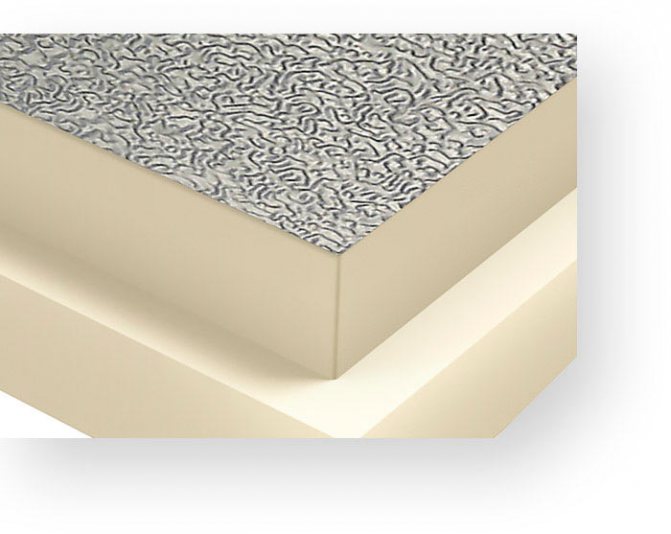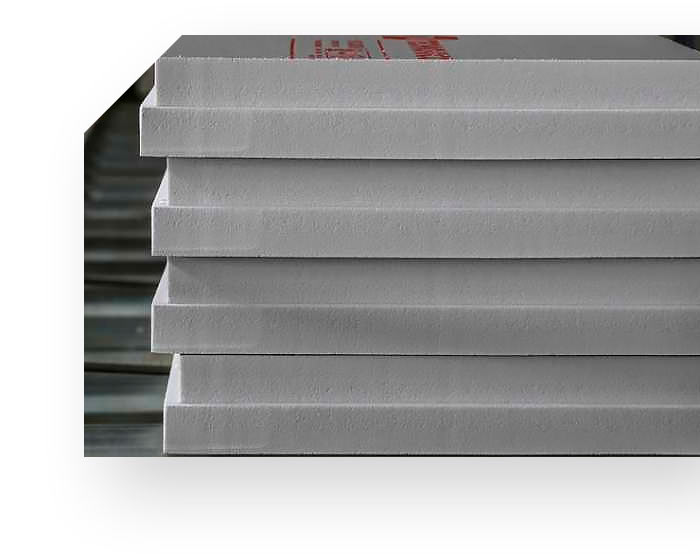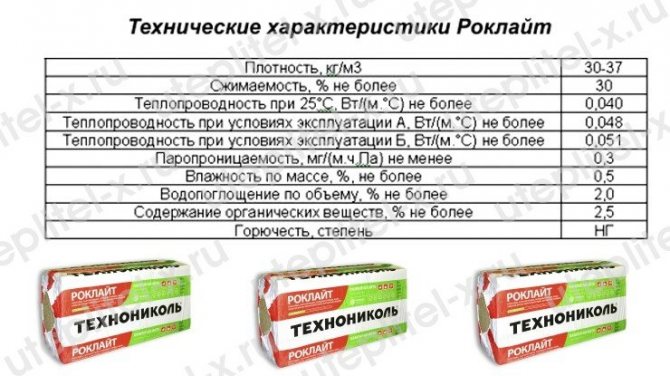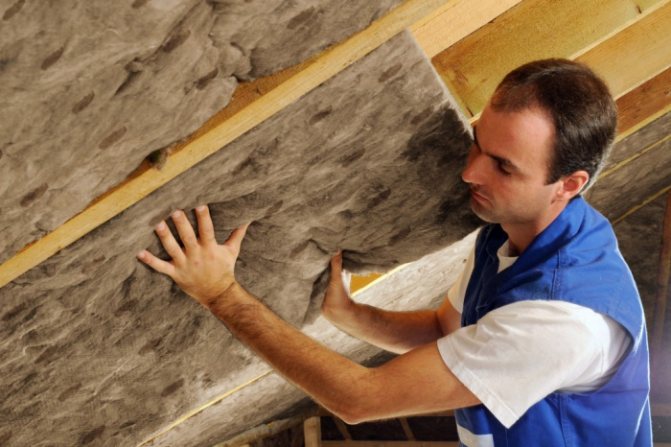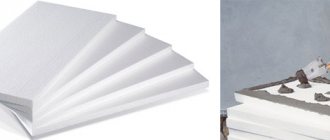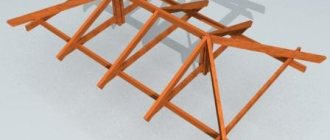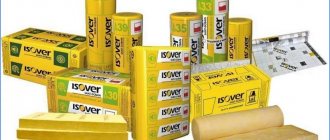Where is the material used
TechnoNicol Rocklight, as already mentioned, is a semi-rigid mineral slab. It can be used in:
- Vertical;
- Horizontal;
- Inclined surfaces.
BUT! No external load. According to the data on the website of the TechnoNicol company, the material has a compression rate of 30%, and the density varies between 30 and 40 kg per m3. This density will be quite enough to withstand the vertical load under its own weight when the insulation is used in frame structures. But, it will not be enough with additional load. Therefore, this thermal insulation is not used in wet facades, but only in hinged ones.
If you give more specific examples of the use of Rocklight, you can highlight:
Sound and thermal insulation of interior partitions;
Insulation of the facade for siding and other hanging systems;
Creation of an attic microclimate.
For example, in the video below, TechnoNicol representatives recommend Rocklight as insulation for the attic.
Rocklight TechnoNICOL installation rules
This material is recommended for thermal insulation of floors in houses and apartments on the first floors, attic floors, roofs, for thermal insulation of building facades for siding, etc. Let's consider further how to properly install Rocklight basalt wool slabs from the Russian company Technonikol, and also show a video instruction with recommendations from the manufacturer at the end of the article.
Insulation of the facade of the house with mineral wool Rocklight
To insulate the facade with TechnoNICOL mineral wool, it is necessary to build a frame from a profile or a bar. The width of the vertical guides should be 1-1.5 cm less than the width of the thermal insulation plates in order to exclude gaps and cold bridges in the structure. After installing the frame, the entire facade is covered with waterproofing so that the mineral wool does not absorb moisture from the walls. The overlap must be at least 150 mm.

Photo. Insulation of the facade with Rocklight TechnoNICOL mineral wool
Rocklite thermal insulation is placed between the guide bars. After installing the thermal insulation, the mineral wool should be protected with a vapor barrier membrane to protect it from atmospheric moisture. The film is laid with the smooth side to the insulation and fixed with a construction stapler to wooden blocks. Next, wooden blocks with a thickness of about 20-30 mm are stuffed on top of the vapor barrier.
The gap between the vapor barrier film and the finishing of the facade is necessary so that moisture from the surface of the film can be freely weathered. It is important to observe this rule when installing any mineral wool, since this material loses its characteristics when wet. Upon completion of the work, the finishing facade cladding, for example, siding, is installed on the wooden blocks.
Insulation of a pitched roof with Rocklight mineral wool
For thermal insulation of any vertical structures, a frame should be built. For the roof, it is necessary to fill a crate of boards from the inside of the rafters, on which the vapor barrier and insulation plates are laid. When laying Rocklight TechnoNICOL slabs, make sure that there are no gaps. To exclude cold bridges, the insulation is put in two layers so that the second layer overlaps the joints of the first layer.
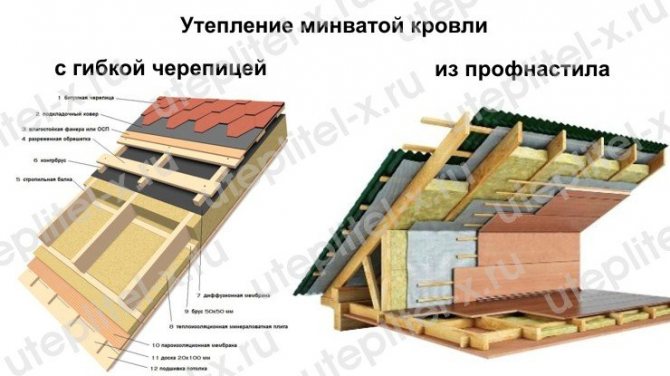

Photo. Roof insulation with Rocklight TechnoNICOL mineral wool
On top of the thermal insulation layer, roll waterproofing is spread with an overlap between the rolls of at least 150 mm. The vapor barrier is attached with a slight sag to the roof rafters so that condensation can drain off. When installing waterproofing, pay attention to which side to correctly lay the vapor barrier to the insulation. Recall that the underside of the vapor barrier must allow moisture vapor from the insulation to pass through.
Before installing the vapor barrier, be sure to read the instructions for use from the manufacturer.
Further, a ventilation gap must be created between the vapor barrier film and the roof. It is necessary for the formed condensate to be freely weathered from the surface of the film. For this, bars with a thickness of 20-30 mm are additionally stuffed on top of the rafters. Read how to properly insulate the roof with mineral wool on the website uteplitel-x.ru in the section "Do-it-yourself roof insulation".
Basalt material characteristics
Mineral wool perfectly resists cold, significantly superior to any other natural or artificial insulators. But when choosing a Rockline insulation from the manufacturer TechnoNIKOL, one should start from personal needs, weighing all the technical advantages and disadvantages of the product.
The thermal conductivity of the material is 0.036W / m. This indicator is consistent with all the standards that are necessary for the device of thermal insulation in cold climates.
The density is 30 kg per cubic meter. m. The indicator is not very high, but it is perfectly combined with the compression ratio, which plays a significant role when using insulation indoors and in attics as thermal insulation. Thanks to him, it will be seen how much it is possible to pull off the cotton wool without deforming it, because by reducing the efforts, it will return to its original shape. The 30% figure is a significant result, which will be quite enough for an easy process of installing mineral slabs into frames on roofs or walls.


The products are produced in packs with sheet sizes 1200 × 600 × 50 mm and 1200 × 600 × 100 mm. These dimensions are the most demanded, since they are conveniently installed in frames, having a low weight. But at the same time, such a thickness of cotton wool is quite enough to provide the structure with the proper degree of thermal insulation in a cold winter. In the case when the layer is not enough, for example, when insulating an attic, then the material can be combined with each other or placed in several levels.
Specifications
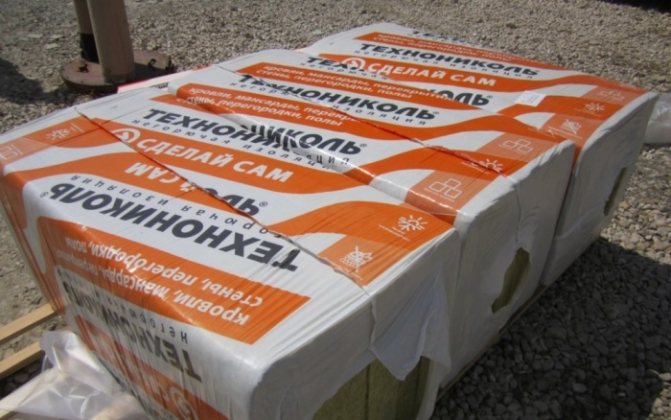

Rocklight slabs are supplied in thermo packing. The standard size of one Rocklight slab is the same as that of Penoplex 60 × 120 cm. This simplifies the handling of the insulation, since there is no need to make any changes to the crate when facing the house with siding or other finishes. The thickness of the slabs varies depending on the needs and can be from 50 to 150 mm. The size of the "Rocklight" package does not change, so the quantity will be smaller with greater thickness. For example, for the minimum thickness, the package can hold 12 boards, and for the maximum thickness only 4. This should be taken into account when planning the delivery of material to the construction site.


Insulation TechnoNIKOL "Rocklight" has a thermal conductivity of 0.039 W / (m2 × K). In terms of technical characteristics, this is an excellent indicator, which is many times superior to other heaters. The density of the insulation is also at the proper level. It can vary from 30 to 40 kg × m3. It is the density that explains the stability of the form of insulation to various influences. The color of the insulation is closest to greenish-yellow. A video about Rocklight insulation can be seen below.
Application
Insulation "Rocklight", reviews of which, perhaps, will allow you to understand in the direction of which thermal insulation to make your choice, has found its widespread use. It is the ideal material for private construction. Stone wool is used for inclined, horizontal and vertical surfaces, as well as for the insulation of corner elements, floor slabs, pitched roofs, foundations and basements. You can purchase this insulation in the event that there is a need to insulate the attic or frame house.For the reason that the density of the material is not so high that it can be used as a supporting structure, it is best to use additionally more durable building elements for this.
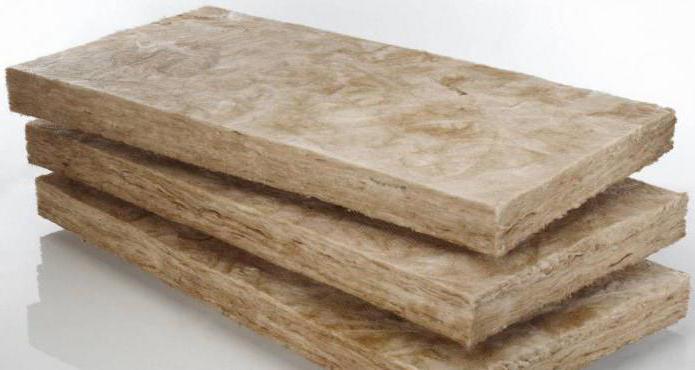

Installation features
Basalt insulation "Rocklight" allows you to save not only at the stage of purchase, but also during installation. Any home craftsman will be able to carry out installation work to install this thermal insulation. The material can be glued or screwed on, filling the resulting joints with construction foam. In this case, the walls are pre-treated with a primer, as an alternative solution is the laying of waterproofing
If we are talking about a pitched roof, then it is important to leave a ventilation gap between the insulation and the structure itself. For this "Rocklight" is mounted directly on the frame beams, which are reinforced from the inside at a distance of 30 centimeters from each other.


The main characteristics and properties of TechnoNIKOL insulation
So, if we talk about such a characteristic of the TechnoNIKOL insulation as thermal throughput in relation to various types of products, then it has a value from 0.028 W / m • K to 0.035 W / m • K.
Judging by the given values, we can conclude that this type of plate copes well with the influence of infrared rays, regardless of which side of the room it was installed on. The use of such stoves allows maintaining a constant thermal regime in the room at any ambient temperature.
If we consider such a characteristic as water absorption, then for TechnoNIKOL slabs it has a value of 0.2% of the volume. This allows the material to perfectly resist moisture and at the same time prevent unpleasant neoplasms on the structures of objects, primarily mold and mildew.
If we talk about vapor permeability, then this parameter has a very insignificant indicator, which is 0.011 mg / (m × h × Pa). The density of this insulation is at a fairly high level and is 26-32 kg * m3. At the same time, certain types of products can be found on sale, for which the value of this parameter can be 60 kg * m3. Such heaters are characterized by the presence of an even and rigid base.
Plates produced by the TechnoNIKOL corporation have a fairly high strength. Their value is sufficient to cope with compression from 250 to 1000 MPa. The peculiarity of the production process of the plates is that it takes place without the use of freons. This fact gives grounds to assert that TechnoNIKOL heaters are environmentally friendly and safe.
A characteristic such as the fire safety of rocklight slabs can be judged by the following indicators:
- according to the degree of combustibility, these plates belong to the G3 group, which allows them to be considered normally combustible;
- in terms of flammability, these heaters can be included in group B2, which speaks of their moderate flammability;
- according to the ability to generate smoke, it is appropriate to include this material in group D3, implying a high ability for this parameter;
- in terms of toxicity of emissions during combustion, TechnoNIKOL stoves are classified as T2, which includes moderately hazardous materials.
Such heaters are able not to lose their performance when interacting with temperatures in the range from - 70 to + 75 degrees. This feature expands the possibilities of their use. Therefore, when building any objects, it is permissible to use such a material. TechnoNicol Rocklight slabs are chemically resistant, so they feel great even in direct contact with any other compounds and surfaces used in the construction of objects.
Universal heaters
We offer for sale universal heaters for unloaded structures of two manufacturers:
- Rocklight - TechnoNICOL corporation;
- Rockwool Light Butts - by Rockwool;
Rocklight
Rocklight - the insulation produced by the TechnoNICOL corporation is a non-combustible heat-insulating material, which consists of stone wool with a density of 30 to 37 kg / m3. This universal insulation is produced in the form of slabs with dimensions of 1200 x 600 mm and thicknesses of 50 and 100 mm. In its manufacture, a melt of rocks is used, drawn into a fiber. The air content distributed over the volume of the material reaches 98%, which makes Rocklight an excellent insulation, regulated in accordance with TU 5762-049-17925162-2006.
Rocklight has the following advantages:
- Low thermal conductivity provides excellent protection of the house from cold and heat;
- Fire safety is guaranteed by the non-combustibility of the chemically neutral material;
- Full vapor permeability allows moisture to leave the building without problems;
- High sound absorption leads to a significant reduction in the level of noise load;
- Biological resistance to microorganisms and rodents;
- High environmental friendliness - no substances harmful to humans.
The scope of Rocklite is diverse and affects such components of frame housing construction as:
- pitched roof;
- brick wall when finishing with siding;
- wall of layered masonry based on brick / aerated concrete;
- interior partitions;
- frame walls;
- floors and floors on logs.
Rocklight universal insulation is used in all types of non-loadable structures - in systems that do not transfer external loads to the insulation. On the inside of the dwelling, it is necessary to use a vapor barrier film. If it is possible for the insulation to come into contact with the environment from the outside, it is necessary to use a wind-moisture protective film. With regard to a frame house, only 2 types of insulation are required: rocklight for walls, floors, roofs and extruded polystyrene foam for the blind area and foundation.
It is worth noting a few nuances:
- You can use a regular sharp knife to cut stone wool;
- the plate should be 1-2 cm wider than the distance between the frame posts;
- the installation of the slab between the structural elements should be accompanied by filling the space in order to exclude cold bridges;
- in the case of a two-layer solution of the slab, it must be laid with overlapping joints.
Geometric dimensions of the slabs:
- Width: 600 mm;
- length: 1200 mm;
- thickness: 50 and 100 mm.
Rocklight Specifications Table
| Options | Value | |
| Density, in kg / m3 | 30,0 — 37,0 | |
| Compressibility,%, no more | 30 | |
| Thermal conductivity, in W / m * С | λ25 | 0,040 |
| λА | 0,048 | |
| λB | 0,051 | |
| Water vapor permeability, in mg / (m * h * Pa), not less | 0,3 | |
| Flammability group | NG | |
| Water absorption by volume, in%, no more | 2 | |
The price of Rocklight can be checked with the managers of our sales department.
Rockwool
Rockwool is a non-combustible heat-insulating material based on stone wool with a density of 37-210 kg / m3. This type of universal insulation is produced in the form of plates with a size of 1000 x 600 mm and a thickness of 50 - 200 mm, with a pitch of 10 mm. The production of the material is based on rock melt pulled into a fiber. The service life with correct operation and installation is more than 50 years. The density of Rockwool stone wool determines its use in various systems.
Rockwool has a number of advantages:
- flammability group of the material - NG (non-combustible);
- the hydrophobized plate has increased moisture resistance;
- biologically inactive material that does not rot or decompose;
- can be used for the purpose of insulation in any type of structure.
The requirements for the construction of a flat roof subdivide universal insulation into various types, differing in density:
| Type of material | Density material | Scope of Rockwool |
| Light Butts | 37 | In any non-stressed structures such as frame walls, floors, ceilings and roofs |
| Acoustic Butts | 45 | As a middle layer in structures using frame sheathing partitions and cladding, interfloor ceilings or for the purpose of additional sound insulation of ceilings |
| Caviti Butts | 45 | As an insulating middle layer in three-layer exterior walls made of small-sized materials |
| Venti Butts | 90 | As thermal insulation on the outside of ventilated façade structures |
| Facade Butts | 145 — 180 | Provides not only thermal insulation, but also a base for applying a plaster layer |
| Roof Butts | 115 — 210 | As a lower and upper heat and sound insulation layer in single-layer, multi-layer loadable roofing and for roofing without using a cement screed |
Geometric dimensions of the slabs:
- width: 600 mm;
- length: 1000 mm.
Plates of this type of universal insulation are packed in plastic wrap, which has a red color with a logo. The number of sheets of thermal insulation material in a pack varies depending on the thickness.
Rockwool Butts specification table
| Options | Value | |
| Density, in kg / m3 | 37,0 | |
| Compressibility,%, no more | 30 | |
| Water vapor permeability, in mg / (m * h * Pa), not less | 0,30 | |
| Acidity modulus, not less | 2,0 | |
| Flammability group | NG | |
| Thermal conductivity, in W / (m * K) | λ10 | 0,036 |
| λ25 | 0,037 | |
| λА | 0,039 | |
| λB | 0,041 | |
You can find out the price of the Rockwool Butts product line from the sales managers of our company.
Features of the
The features or advantages of this insulation follow from the definition, namely:
- Fire safety. The insulation has a class NG, which means it does not contribute to the spread of fire. For many consumers, this factor is decisive when choosing a heater made of stone wool. The latter is preferred over polystyrene, which emits toxic substances when burned.
- High vapor permeability. The thermos effect is good only in the case of tea in winter. But the room to a reasonable extent should not only preserve, but also REMOVE heat or moisture. Otherwise, over time, a living room or office would turn into a steam room.
- Convenience and simplicity when insulating. Minwata Rocklight provides for wet-free styling. And this type of installation is faster, more convenient and simpler.
- Low thermal conductivity. For the central regions of Russia, a 50 mm insulation is recommended, although there are much denser options.
Rocklight vs. Styrofoam
Since the price of polystyrene is much lower than the cost of mineral wool from Technonikol, many often choose a cheaper option for insulation material. Of course, it is more profitable to pay 200-300 rubles for a package than 600-800 rubles. But how will the foam behave in practice and what is Rocklite capable of giving?
The strengths of the foam include its lightness, ease of installation and affordable cost.
But Rocklite, as opposed to foam, provides important advantages:
- The material is not subject to combustion. The mineral wool will not spread the resulting fire, but will simply start to gradually melt. Styrofoam ignites and burns very actively;
- Duration of service life. Polyfoam can effectively serve for 10 years, after which its gradual process of destruction begins. Rocklight mineral wool has been in service for over 50 years while maintaining its original technical characteristics;
- Polyfoam is simply adored by rodents. In many houses, they gnaw through the insulation and settle under the ceiling or in the walls. Mineral insulation is not characterized by such features;
- Providing wall ventilation. By insulating rooms with mineral wool, they can breathe. If you use polystyrene foam, the room will turn into a kind of thermos. The moisture removal will have to be carried out through a specially installed ventilation system. This is unnecessary financial costs and time.
disadvantages
This is not to say that the product of TechnoNIKOL is an ideal insulation, better than which nothing exists. This is not true. Each insulation shows its negative qualities to one degree or another. If you use mineral wool correctly and for its intended purpose, you will not find out about the shortcomings. But if you violate the recommendations, the cons will surely come out.
Mineral wool does not absorb moisture, but due to its effect, the material is still capable of gradually deteriorating. When working with mineral wool, it is imperative to use waterproofing materials. These are additional costs and labor. Is this a disadvantage? For some, yes. I combine thermal insulation from Rocklight mineral wool with waterproofing materials, you need to carefully evaluate the properties of the latter. Some insulators are capable of keeping out moisture and air at the same time
Therefore, an important advantage of mineral wool is lost due to improper insulation design. So, by insulating the floor and ceiling at the same time, it will be just as hard to breathe inside the room as if you were using foam.
https://youtube.com/watch?v=JYHrMfDMNkM
Minwata Rocklight: the main properties of the insulation:
- The material has a low thermal conductivity, which can be compared with expensive and high-quality materials, for example, URSA;
- Rocklight mineral wool can withstand temperatures up to 450 degrees and open fire, prevents the spread of fire in a possible fire;
- Mineral wool slabs do not cake, maintaining the stability of their original dimensions and shape for many years. The service life of mineral wool is about 50 years;
- Rocklight TechnoNICOL can also be used in interior partitions for sound insulation. The material is resistant to rodents, does not decompose or rot.
Minuses
Although, in general, TechnoNicol products have established themselves in the market, as you know, there are no ideal things. This means that Rocklite has its own "dark" sides.
Firstly, users note that mice do eat it. And if they do not eat, then they gnaw for sure. Therefore, like polystyrene, the insulation needs to be erected with a dense frame, through which the unexpected inhabitants of your house cannot get to it.
Secondly, is it worth attributing to the shortcomings of the insulation itself ... or, rather, the approach to choice is flammability. Although TechnoNicol cotton wool itself does not burn or melt, you should not expect that in case of a fire, the insulation will do a miracle, say, in a wooden house. Walls made of wood, OSB or other combustible materials will burn and mineral wool, although it will not promote combustion, will definitely not be able to stop a huge fire.
Thirdly, we have already spoken about the release of harmful substances (unconfirmed!).
Fourth, consumers complain about poor adhesion or contact with alkaline-based wall finishing materials.
In addition, they report the hydrophobicity of the insulation, the fragility of the sheets, and some say that even when buying, the sheets in the package are deformed and dented, which makes it very difficult to install the plates.
Advantages of mineral wool TechnoNIKOL Rocklight
As we have already said, not every thermal insulation material is universal in its application. Due to its environmental friendliness and dimensional stability, Rocklight should be used for insulating interfloor ceilings, attics and attics of buildings, and house facades. The advantages of Rocklight basalt wool in comparison with foam are expressed in its most important parameters:


Table. Rockwool thermal insulation specifications
1... Non-flammability. Basalt wool does not burn and can withstand high temperatures, unlike foam. 2... The service life of Rocklight TechnoNICOL plates is about 50 years, expanded polystyrene plates are destroyed in 15-20 years. 3... For rodents and insects, mineral wool is indifferent, it provides good ventilation of the structures of the house.
Thermal insulation Technonikol
In the Russian market, TechnoNIKOL has long gained popularity with a wide selection and quality of thermal insulation materials. The range of produced stone wool is produced on the basis of basalt rocks. Basalt fibers are mined by remelting mineral rocks. As a result of production, a very dense and durable material with low thermal conductivity is obtained.
Currently, there are a huge number of different types of materials. Most insulating materials are not only intended as heat insulators. They also have sound insulating properties and help protect structures from damaging influences. The company strives to produce the highest quality product lines.
Types and features of Rocklight heaters
Although the Technonikol company also has an extensive assortment, there are only 2 types of the Rocklight brand: with 50 mm and 100 mm thick. Cotton wool differs from each other only in insignificant overall parameters, in particular the diameter of the layer, in all other respects it is an absolutely identical material in its properties. From 50 mm sheets, you can make a surface thickness of 50, 100 and 150 mm by combining several coatings into one. The size of one slab is 0.72 sq. m, and each package contains from 4-12 pieces.


Mineral wool has many advantages, thanks to which it is quite in demand among numerous buyers, having characteristics that are no worse, and in some places even better than the main competitor - polystyrene.
- Resistant to fire. This insulation prevents the spread of ignition over the surface, thanks to which many buyers prefer it, because when the foam burns, poisonous substances are released that can cause serious harm to health. During a fire, people inside the building will have enough time to evacuate and call the firefighters. The melting temperature is in the region of 1000 degrees, so the mineral wool does not burn, does not smoke and does not run off in scalding drops.
- A low level of moisture absorption is achieved with a preliminary perfect vapor and waterproofing during installation. This property is a tangible advantage and the only disadvantage of the material. If it is used indoors, it should not be used to cover all surfaces to provide fresh air.
- Mineral wool has a long service life, which reaches 50-60 years. Foam sheets begin to deteriorate after 15-20 years.
- Due to its structure, it has excellent sound absorption characteristics and can be used to provide a structure with an effective degree of sound insulation.
- Low biological activity does not contribute to the emergence of harmful fungi and microorganisms, as well as various rodents.
- The material has significant indicators of hardness and rigidity, which is why it is capable of giving in to enormous loads. Even after a long service life, Rocklight insulation is not prone to shrinkage, retaining its original slab shape and efficiency.
- The insulator does not corrode and is resistant to alkalis.
- Basalt wool is absolutely environmentally friendly. It does not contain components harmful to human health.
- The available vapor permeability allows passing and retaining the required level of heat and moisture, producing ventilation of the room.


What is the material
General information
Rocklight insulation is a mineral wool slab from the well-known domestic manufacturer Technonikol. These slabs are based on interwoven fibers obtained by melting basalt rocks.
The insulation contains binding components that glue the fibers together, as well as a hydrophobizing impregnation that increases the moisture resistance of the material.
The high thermal insulation properties of this insulation are due to the fact that 98% of its volume is occupied by air.


Due to the water-repellent additive, the insulation has moisture-repellent properties
Basic qualities
Like any other thermal insulation material, Rocklight slabs have both advantages and disadvantages, which we will look at below.
Pros:
- Low thermal conductivity. As a result, the insulation can be used as a filler in frame walls and other structures;
- Environmental friendliness. There are no toxic materials in the slabs. In addition, basalt fibers do not cause skin irritation and allergies as much as glass wool.
- Water vapor permeability. This property allows you to provide a favorable microclimate in housing;


Basalt wool is fire resistant
- Fire safety. Basalt wool slabs do not burn at all. In addition, the material is fire resistant, i.e. able to protect against fire;
- Durability. The insulation serves for more than 50 years, while the manufacturer gives a guarantee of 30-40 years;
- Good sound insulation properties. This allows Rocklight slabs to be used not only as a heat-insulating material, but also as a sound-insulating material;


Plates retain their shape and volume well
- Form stability. Plates do not shrink or deform over time;
- Resistance to negative biological influences. Basalt wool slabs are not afraid of rodents and insects. In addition, the material is not subject to combustion.
Minuses:
- Moisture instability. As a result of the fibrous structure of mineral wool, the boards absorb moisture quite strongly, even despite the hydrophobic impregnation. The latter are only able to temporarily protect the insulation from moisture. Therefore, when installing the slabs, it is imperative to use a hydro-vapor barrier;


When insulating frame structures with mineral wool, it is imperative to use vapor-waterproofing, as shown in the diagram
- Low strength. The material in question has a low density and rather low strength. Therefore, it can only be used in frame structures, where the insulation will not be subjected to loads;
- High price. The price of the package is about 600 rubles, 0.432 m3 of basalt wool in the package. Many insulation materials are cheaper. Keep in mind that the price is current in the spring of 2020;
Stone wool, although to a lesser extent than glass wool, still causes irritation when it gets on the skin. Therefore, it is necessary to work with it with gloves. In addition, it is desirable to protect the respiratory system.
Specifications
Rocklight insulation has the following characteristics:
| Specifications | The values |
| Thermal conductivity, W / (m * K) | Not more than 0.041 |
| Water vapor permeability, mg / (m h Pa) | 0,3 |
| Water absorption,% of the volume | 2 |
| Density, kg / m3 | 30-40 |
| Dimensions, mm | 1200X600 |
| Thickness, mm | 50-150 |


Rocklight slabs can be used for internal wall insulation

